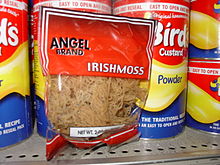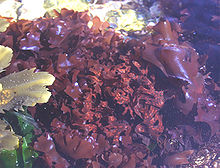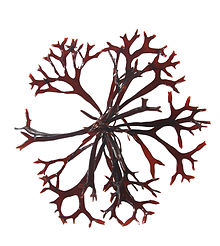- Chondrus crispus
-
Irish moss 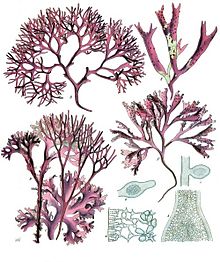
A-D Chondrus crispus ; E-F Mastocarpus stellatus Scientific classification Domain: Eukaryota Kingdom: Protista (unranked): Archaeplastida Division: Rhodophyta Class: Rhodophyceae Order: Gigartinales Family: Gigartinaceae Genus: Chondrus Species: C. crispus Binomial name Chondrus crispus
StackhouseChondrus crispus, known under the common name Irish moss, or carrageen moss (Irish carraigín, "little rock"), is a species of red algae which grows abundantly along the rocky parts of the Atlantic coast of Europe and North America. In its fresh condition the protist is soft and cartilaginous, varying in color from a greenish-yellow, through red, to a dark purple or purplish-brown. The principal constituent of Irish moss is a mucilaginous body, made of the polysaccharide carrageenan of which it contains about 55%. The protist also consists of nearly 10% protein and about 15% mineral matter, and is rich in iodine and sulfur. When softened in water it has a sea-like odour, and because of the abundant cell wall polysaccharides it will form a jelly when boiled, containing from 20 to 100 times its weight of water.
Contents
Description
Chondrus crispus is a relatively small red alga, reaching up to a little over than 20 cm in length. It grows from a discoid holdfast and branches four or five times in a dichotomous, fan-like manner. The morphology is highly variable, especially the broadness of the thalli. The branches are 2–15 mm broad, firm in texture and dark reddish brown in colour bleaching to yellowish in sunlight. The gametophytes (see below) often show a blue iridescence and fertile sporophytes show a spotty pattern. Mastocarpus stellatus (Stackhouse) Guiry is a similar species which can be readily distinguished by its strongly channelled and often somewhat twisted thallus. The cystocarpic plants of Mastocarpus show reproductive papillae[clarification needed] quite distinctively different from Chondrus.[1] When washed and sun-dried for preservation, it has a yellowish, translucent, horn-like aspect and consistency.
Distribution
Chondrus crispus is common all around the shores of Ireland and Great Britain and can also be found along the coast of Europe including Iceland, the Faroe Islands [2] western Baltic Sea to southern Spain.[1] It is found on the Atlantic coasts of Canada[1][3] and recorded from California in the United States to Japan.[1] However, any distribution outside the Northern Atlantic needs to be verified. There are also other species of the same genus in the Pacific Ocean, for example, C. ocellatus Holmes, C. nipponicus Yendo, C. yendoi Yamada et Mikami, C. pinnulatus (Harvey) Okamura and C. armatus (Harvey) Yamada et Mikami.[4]
Ecology
Chondrus crispus is found growing on rock from the middle intertidal zone into the sublittoral.
Uses
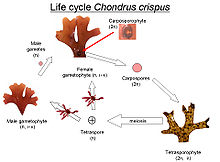 The life cycle of Chondrus crispus. Below the life stage are indicated if the life stage is haploid(n) or diploid (2n) and the type of carrageenan present.
The life cycle of Chondrus crispus. Below the life stage are indicated if the life stage is haploid(n) or diploid (2n) and the type of carrageenan present.
Chondrus crispus is an industrial source of carrageenan, which is commonly used as a thickener and stabilizer[5] in milk products such as ice cream[6] and processed foods, including lunch meat. In Europe, it is indicated as E407 or E407b. It may also be used as a thickener in calico-printing and for fining beer or wine. Irish moss is frequently mixed with Mastocarpus stellatus (Gigartina mammillosa), Chondracanthus acicularis (G. acicularis) and other seaweeds with which it is associated in growth. Carrageenan and agar-agar are also used in Asia for gelatin-like desserts, such as almond jelly. Presently, the major source of carrageenan is tropical seaweeds of the genera Kappaphycus and Eucheuma.[citation needed]
In parts of Scotland (where it is known as (An) Cairgean in Scottish Gaelic) and Ireland, it is boiled in milk and strained, before sugar and other flavourings such as vanilla, cinnamon, brandy or whisky are added.[7] The end-product is a kind of jelly similar to pannacotta, tapioca, or blancmange.[8]
Irish moss is commonly used as a clarifying agent in the process of brewing (beer), particularly in homebrewing. A small amount is boiled with the wort, attracting proteins and other solids, which is then removed from the mixture after cooling.
Life history
Chondrus crispus undergoes an alternation of generation life cycle common in many species of algae (see figure below). There are two distinct stages: the sexual haploid gametophyte stage and the asexual diploid sporophyte stage. In addition, there is a third stage- the carposporophyte, which is formed on the female gametophyte after fertilization. The male and female gametophytes produce gametes which fuse to form a diploid carposporophyte, which forms carpospores, which develops into the sporophyte. The sporophyte then undergoes meiosis to produce haploid tetraspores (which can be male or female) that develop into gametophytes. The three stages (male, female and sporophyte) are difficult to distinguish when they are not fertile; however, the gametophytes often show a blue iridescence.
Names in various languages
Language Names English Irish moss, pearl moss, carrageen moss, seamuisin, curly moss, curly gristle moss, Dorset weed, jelly moss, sea moss, white wrack, ragglus fragglus French petit goémon, mousse d’Irlande, lichen (carraghèen), goémon frisé, goémon blanc, goémon rouge, mousse perlée Breton pioka, liken ruz, teil piko, bouch, bouchounoù, bejin behan, bejin gwenn, bouch farad youd, bouch gad, bouch gwenn, jargod, ougnachou-ru, teles, tilez Scottish (Gaelic) An cairgein, killeen, mathair an duilisg Irish carraigín, fiadháin, clúimhín cait, mathair an duilisg, ceann donn Welsh mwsog Iwerddon Faroese Karrageentari Turkish karragen Russian ирландский мох, карраген Polish chrząstnica, chrząścica Portuguese musgo gordo, folha de alface, folhina, botelho crespo Italian muschio irlandese Galician ouca riza, carrapucho, creba, pata de galiña Spanish musgo de Irlanda, musgo perlado, musgo marino, carrageen, liquen German Knorpeltang, Carrageen, Irländischer Perltang, Irländisches Moos, Karragaheen, Perlmoos Swedish karragenalg (karragentång) Norwegian krusflik, driesflik, gelatintang Danish Carrageentang, Blomkålstang, Irlandsk mos Dutch Iers mos Icelandic Fjörugrös Japanese hirakotoji, tochaka, tsunomata Filipino gulaman Catalan molsa d’Irlanda, molsa marina o molsa perlada Scientific interest
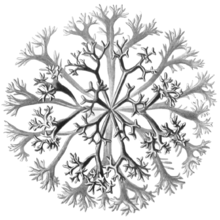 The portion of the 65th plate of Ernst Haeckel's Kunstformen der Natur (1904), depicting Florideae Chondrus crispus, i.e. Irish moss.
The portion of the 65th plate of Ernst Haeckel's Kunstformen der Natur (1904), depicting Florideae Chondrus crispus, i.e. Irish moss.
Chondrus crispus is, compared to most other seaweeds, well-investigated scientifically. It has been used as a model species to study photosynthesis, carrageenan biosynthesis, and stress responses.
See also
Harvey, M.J. & McLachlan, J. 1973. Chondrus crispus. Proc. Trans. Nova Scotian Inst. Sci. 27 (Suppl.): 1 - 155.
References
- ^ a b c d P. S. Dixon & L. M. Irvine (1977). Seaweeds of the British Isles. Vol. 1 Rhodophyta Part 1: Introduction, Nemaliales, Gigartinales. British Museum (Natural History) London. ISBN 0-565-00781-5.
- ^ F. Börgesen (1903). "Marine Algae of the Faröes". Botany of the Faröes based upon Danish investigations Part II (Copenhagen Reprint 1970). pp. 35. ISBN 0-90-6105-011-1.
- ^ W. R. Taylor (1972). Marine Algae of the Northeastern Coast of North America. University of Michigan Press, Ann Arbor. ISBN 0-472-04904-6.
- ^ Hu, Z., Critchley, A.T., Gao T, Zeng X, Morrell, S.L. and Delin, D. 2007 Delineation of Chondrus (Gigartinales, Florideophyceae) in China and the origin of C. crispus inferred from molecular data. Marine Biology Research, 3: 145-154
- ^ Roeck-Holtzhauer, Y.de 1991. Uses of seaweeds in Cosmetics. in Guiry, M.D. and Blunden, G. 1991 Seaweed Resources in Europe: Uses and Potential. John Wiley & Sons ISBN 0-471-92947-6
- ^ Stegenga, H., Bolton, J.J., and Anderson, R.J. 1997. Seaweeds of the South African West Coast. ed. Hall, A.V. Bolus Herbarium Number 18 Cape Town. ISBN 0-7992-1793-X
- ^ Feum à Feamainn (DVD, Scottish Gaelic), Comhairle nan Eilean Siar
- ^ [1] Lusan a' Chladaich (Western Isles Council, Scottish Gaelic site)
External links
- Summers, Adam (July 2006). "Keep Me Hanging On : Surviving in the intertidal zone tests the rubbery limits of algae". Natural History 115 (6): 26–27. http://naturalhistorymag.com/0706/0706_biomechanics.html.[dead link]
- AlgaeBase: Chondrus crispus
- Chondrus crispus Stackhouse Chondrus crispus.
- Marine Life Information Network
- Irish Moss industry on Prince Edward Island [2]
Categories:- Edible algae
- Red algae
- Flora of Jamaica
- Demulcents
Wikimedia Foundation. 2010.

